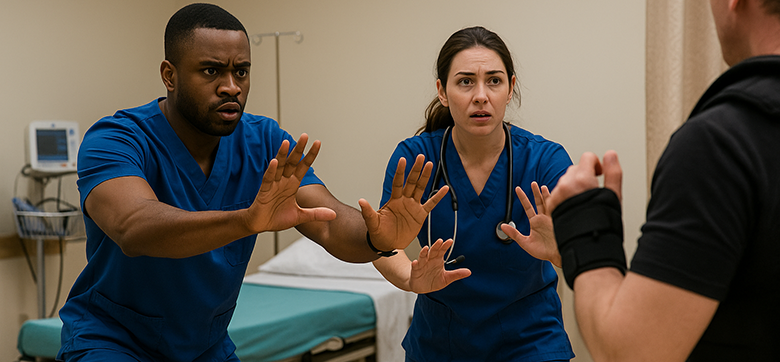In high-stress situations, healthcare professionals don't rise to the level of their expectations—they fall to the level of their training. This reality explains why even well-informed staff may struggle to apply de-escalation techniques during actual crisis scenarios: knowledge alone is insufficient. To perform effectively under pressure, frontline staff need conflict management skills embedded as muscle memory—automatic responses that can be executed without conscious deliberation even when stress impairs cognitive function.
The Neuroscience of Crisis Response
Understanding the brain's functioning during crisis scenarios reveals why muscle memory is essential:
Amygdala hijack: During threatening situations, the brain's alarm system (amygdala) can override the prefrontal cortex, impairing access to recently learned information
Cognitive narrowing: Stress causes attention to narrow, making it difficult to consider multiple options or remember complex procedures
Working memory limitations: Under pressure, working memory capacity decreases, reducing ability to process new information
Automaticity advantage: Well-practiced skills encoded in procedural memory remain accessible even when cognitive function is compromised
Stress-induced regression: Without sufficient practice, people typically revert to habitual responses rather than applying newer techniques
These neurological realities explain why knowledge-based training alone fails to prepare staff for actual crisis situations.
Developing True Muscle Memory
Effective muscle memory development requires specific training approaches:
Progressive skill building: Moving from basic elements to complex application through structured progression
Distributed practice: Spacing skill practice over time rather than massing it in single sessions
Varied scenario exposure: Practicing skills across different contexts and situations to prevent context-dependent learning
Stress inoculation: Gradually introducing pressure during training to build performance under stress
Overlearning: Continuing practice beyond initial mastery to develop automaticity
Feedback incorporation: Receiving and applying specific feedback during skill development
Retrieval practice: Actively recalling and applying techniques rather than passive review
These evidence-based approaches transform intellectual understanding into embodied capability.
The Vistelar Methodology for Muscle Memory Development
Vistelar's training approach incorporates muscle memory development through:
Unified framework: The 6 C's methodology (Context, Contact, Conflict, Crisis, Combat, Closure) creates a consistent structure that becomes automatic with practice
Simplified techniques: Methods like Universal Greeting and Redirection are designed for easy recall and application under pressure
Recognizable patterns: Consistent skill patterns that can be adapted to various situations reduce cognitive load
Realistic scenario practice: Training in situations that mirror actual workplace challenges builds context-relevant capabilities
Performance assessment: Skill demonstration under progressively challenging conditions ensures genuine capability
This approach creates the foundation for effective performance under pressure.
Beyond Initial Training: Sustaining Muscle Memory
Muscle memory requires ongoing reinforcement through:
Regular refresher activities: Brief, focused practice sessions that maintain skill accessibility
Just-in-time review: Pre-shift reminders before entering high-risk situations
Team-based practice: Group simulation exercises that build coordination while reinforcing individual skills
Video review: Analyzing recorded demonstrations to refine technique and reinforce proper execution
Mental rehearsal: Guided visualization of skill application in specific situations
These sustainment activities prevent skill decay while continuing to strengthen neural pathways for automatic execution.
Environmental Supports for Muscle Memory Activation
Physical environment and workflow elements can support muscle memory activation:
Visual cues: Strategically placed reminders in high-risk areas that trigger recall of specific techniques
Team signals: Established code words or gestures that activate shared response patterns
Physical space design: Environmental features that support proper positioning and technique application
Technology aids: Mobile apps or other digital tools that provide in-the-moment guidance
Workflow integration: Procedures that incorporate conflict management steps into standard processes
These environmental supports serve as bridges between training and application, especially during early implementation.
Measuring Muscle Memory Development
To ensure genuine capability rather than assumed readiness, organizations should implement:
Simulation-based assessment: Evaluating performance in realistic scenarios under varied conditions
Surprise drills: Unannounced practice situations that test genuine readiness
Stress-induced testing: Assessment under conditions that mirror the physiological and psychological states of actual crises
Performance timing: Measuring response speed as an indicator of automaticity
Application consistency: Evaluating technique application across different contexts and conditions
These measurement approaches provide objective evidence of readiness while identifying specific improvement needs.
Implementation Strategies for Healthcare Organizations
To build genuine muscle memory throughout your organization:
- Review current training to assess how well it incorporates muscle memory development principles
- Enhance initial training with progressive skill building and extensive practice opportunities
- Implement sustainment strategies including regular refreshers and team-based practice
- Create environmental supports that bridge the gap between training and application
- Establish measurement approaches that assess genuine capability rather than knowledge
- Develop improvement cycles based on performance assessment findings
By focusing on muscle memory development rather than just knowledge acquisition, healthcare organizations create frontline teams genuinely prepared to manage crisis situations effectively, even under extreme pressure. The result is enhanced safety for both staff and patients through consistent, confident application of conflict management skills when they matter most.








